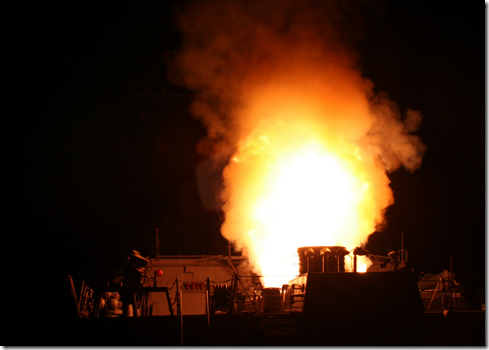I have some friends who do some work for three letter acronyms entities and they pointed me to AFRICOM as some innovative thinking. One of things that is useful going to the AFRICOM Military website is you can get access to the public documents and images shared on things like the US Military activities in Libya that media outlets reuse.
Here are a few pictures that are open for the public to view.
MEDITERRANEAN SEA - Arleigh Burke-class guided-missile destroyer USS Stout (DDG 55) launches a Tomahawk missile in support of Operation Odyssey Dawn on March 19, 2011. This was one of approximately 110 cruise missiles fired from U.S. and British ships and submarines that targeted about 20 radar and anti-aircraft sites along Libyaaâ€s Mediterranean coast. Joint Task Force Odyssey Dawn is the U.S. Africa Command task force established to provide operational and tactical command and control of U.S. military forces supporting the international response to the unrest in Libya and enforcement of United Nations Security Council Resolution (UNSCR) 1973. UNSCR 1973 authorizes "all necessary measures" to protect civilians in Libya under threat of attack by Qadhafi regime forces. JTF Odyssey Dawn is commanded by U.S. Navy Admiral Samuel J. Locklear, III. (U.S. Navy photo by Petty Officer 2nd Class Nathan Pappas) [20110320132841 ]
MEDITERRANEAN SEA - The Arleigh Burke-class guided-missile destroyer USS Stout launches a Tomahawk missile in support of Operation Odyssey Dawn, March 19, 2011. This was one of approximately 110 cruise missiles fired from U.S. and British ships and submarines that targeted about 20 radar and anti-aircraft sites along Libya's Mediterranean coast. Joint Task Force Odyssey Dawn is the U.S. Africa Command task force established to provide operational and tactical command and control of U.S. military forces supporting the international response to the unrest in Libya and enforcement of United Nations Security Council Resolution 1973. (U.S. Navy photo by Petty Officer 3rd Class Jeramy Spivey) [20110320124046 ]
MEDITERRANEAN SEA - Petty Officer 2nd Class Joseph Fremen, with Helicopter Sea Combat Squadron (HSC) 22, calibrates the forward looking infrared (FLIR) system of a MH-60S Knight Hawk helicopter on the flight deck of amphibious assault ship USS Kearsarge (LHD 3) in support of Operation Odyssey Dawn, March 19, 2011. The FLIR system allows pilots a 360-degree view of the area surrounding the helicopter. Joint Task Force Odyssey Dawn is the U.S. Africa Command task force established to provide operational and tactical command and control of U.S. military forces supporting the international response to the unrest in Libya and enforcement of United Nations Security Council Resolution (UNSCR) 1973. UNSCR 1973 authorizes all necessary measures to protect civilians in Libya under threat of attack by Qadhafi regime forces. JTF Odyssey Dawn is commanded by U.S. Navy Admiral Samuel J. Locklear, III. (U.S. Navy photo by Petty Officer 3rd Class Scott Pittman) [20110320131427 ]
This AFRICOM press release was more informative than most media articles out there if you are looking for facts.
Beginning late on March 19, 2011, the U.S. military launched strikes against selected military targets in Libya, launching more than 120 Tomahawk cruise missiles from U.S. ships and U.S. and British submarines.
U.S military assets that participated in the strikes include: two U.S. Navy ships and three submarines; 15 U.S. Air Force aircraft, including the B-2 Spirit Bomber and four U.S. Marine Corps AV-8B Harriers all of which launched strikes against targets in Libya. These targets include SA-5, SA-3 and SA-2 air defense systems around Libyan airfields and various munitions sites. U.S. Navy EA-18G Growlers provided electronic warfare support....
In a statement late March 19, U.S. AFRICOM commander General Carter Ham discussed U.S. and international objectives. Ham stated, "Our goals are simple: We want to protect innocent civilians, prevent attacks against civilian communities, and deter mass atrocities."
U.S. leaders and their international counterparts have defined clear objectives for military actions, Ham noted. These include:
- A cease-fire must be implemented and all attacks against civilians must stop
- Troops must stop advancing against Benghazi and must be pulled back from Ajdabiya, Misrata, and Zawiya.
- Water, electricity, and gas supplies must be turned on to all areas.
- Humanitarian assistance must be allowed to reach the people of Libya.

